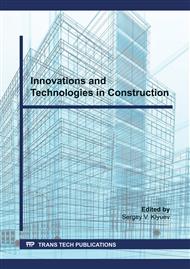[1]
S.-A.Yu. Murtazaev, M. Sh. Salamanova, M.S. Saidumov, Z.Kh. Ismailova, Influence of active surface centers on the reactivity of mineral additives, Modern Science and Innovations (2017). 2(18). Pp. 168-175.
Google Scholar
[2]
D.K-S. Bataev, S.-A. Yu. Murtazaev, M.Sh. Salamanova, S.S. Viskhanov, Utilization of Cement Kiln Dust in Production of Alkali-Activated Clinker-Free Binders, Proceedings of the International Symposium Engineering and Earth Sciences: Applied and Fundamental Research, (ISEES 2019).1. - Pp. 457-460.
DOI: 10.2991/isees-19.2019.89
Google Scholar
[3]
R. Fediuk, Reducing permeability of fiber concrete using composite binders, Special Topics and Reviews in Porous Media (2018). 9(1). pp. v-vi.
DOI: 10.1615/specialtopicsrevporousmedia.v9.i1.100
Google Scholar
[4]
B. Nematollahi, J. Sanjayan, Efficacy of Available Superplasticizers on Geopolymers, Research Journal of Applied Sciences, Engineering and Technology (2014). 7(7). Pр.1278-1282. http://www.maxwellsci.com/print/rjaset/v7-1278-1282.pdf.
DOI: 10.19026/rjaset.7.420
Google Scholar
[5]
D. Hardjito, S.E. Wallah, D.M.J. Sumajouw, B.V. Rangan, Properties of geopolymer concrete with fly ash source material: effect of mixture composition, Seventh CANMET/ACI international conference on recent advances in concrete technology, Las Vegas, USA (2002). Pр.1018-1023.
DOI: 10.14359/13308
Google Scholar
[6]
R. Fediuk, A. Pak, D. Kuzmin, Fine-Grained Concrete of Composite Binder. IOP Conference Series: Materials Science and Engineering. (2017). 262(1). 012025. https://doi.org/10.1088/1757-899X/262/1/012025.
DOI: 10.1088/1757-899x/262/1/012025
Google Scholar
[7]
S. Alonso, A. Palomo, Alkaline activation of metakaolin and calcium hydroxide mixtures: influence of temperature, activator concentration and solids ratio, Materials Letters (2001). 47(1-2). Pр.55-62.
DOI: 10.1016/s0167-577x(00)00212-3
Google Scholar
[8]
A.A. Soldatov, I.V. Sariev, M.A. Zharov, M.A. Abduraimova, Building materials based on liquid glass / А.А. Soldatov, Actual problems of construction, transport, mechanical engineering and technosphere safety Proceedings of the IV-th annual scientific-practical conference of the North Caucasus Federal University (2016). Pp. 192-195.
Google Scholar
[9]
R. Fediuk, A. Smoliakov, N. Stoyushko, Increase in composite binder activity. IOP Conference Series: Materials Science and Engineering (2016). 156(1). 012042.
DOI: 10.1088/1757-899x/156/1/012042
Google Scholar
[10]
N.I. Kozhukhova, R.V. Chizhov, I.V. Zhernovsky, V.V. Strokova, Structure formation of geopolymer perlite binder vs. Type of alkali activating agent, International Journal of Pharmacy and Technology (2016). 8(3). Pр. 15338–15348.
Google Scholar
[11]
S.-A.Yu. Murtazaev, M. Sh. Salamanova, Prospects for the use of thermally activated raw materials of aluminosilicate nature, Privolzhsky scientific journal (2018). 46. Pp. 65–70.
Google Scholar
[12]
R.S. Fediuk, A.K. Smoliakov, R.A. Timokhin, V.O. Batarshin, Y.G. Yevdokimova, Using thermal power plants waste for building materials. IOP Conference Series: Earth and Environmental Science (2018). 87(9). 092010.
DOI: 10.1088/1755-1315/87/9/092010
Google Scholar
[13]
S.-A.Yu. Murtazaev, M.Sh. Salamanova, M.Sh. Mintsaev, R.G. Bisultanov, Fine-Grained Concretes with Clinker-Free Binders on an Alkali Gauging (Fine-grained concrete based on alkaline activated binders), Proceedings of the International Symposium Engineering and Earth Sciences: Applied and Fundamental Research, (ISEES 2019).1. Pp. 500-503.
DOI: 10.2991/isees-19.2019.98
Google Scholar
[14]
M.Sh. Salamanova, S.-A.Yu. Murtazaev, Cements of alkaline activation: the possibility of reducing the energy consumption of obtaining building composites, Building materials (2019). 7. Pp. 32-41.
Google Scholar
[15]
R.S. Fediuk, V.S. Lesovik, A.P. Svintsov, N.A. Gladkova, R.A. Timokhin et al, Self-compacting concrete using pretreatmented rice husk ash, Magazine of Civil Engineering (2018). 79(3). Pp. 66-76.
Google Scholar
[16]
A. Obata, T. Kasuga, J. R. Jones, Hydroxyapatite Coatings Incorporating Silicon Ion Releasing System on Titanium Prepared Using Water Glass and Vaterite, Journal of the American Ceramic Society (2011). 94(7). Pp. 2074-2079.
DOI: 10.1111/j.1551-2916.2011.04402.x
Google Scholar
[17]
J. Reinik, I. Heinmaa, J.P. Mikkola, U. Kirso, Hydrothermal alkaline treatment of oil shale ash for synthesis of tobermorites, Fuel (2007). 86. - Pp. 669-676.
DOI: 10.1016/j.fuel.2006.09.010
Google Scholar
[18]
T. Abirami, M. Loganaganandan, G. Murali, R. Fediuk, R. Vickhram Sreekrishna, T. Vignesh, G. Januppriya, K. Karthikeyan, Experimental research on impact response of novel steel fibrous concretes under falling mass impact. Construction and Building Materials (2019). 222. Pp. 447-457. https://doi.org/10.1016/j.conbuildmat.2019.06.175.
DOI: 10.1016/j.conbuildmat.2019.06.175
Google Scholar
[19]
P.V. Krivenko, Zh.V. Skurchinskaya, Yu.A. Sidorenko, Slag-alkali binders of a new generation, Cement (1991). 11-12. Pp. 4-8.
Google Scholar
[20]
R. Fediuk, A. Smoliakov, A. Muraviov, Mechanical properties of fiber-reinforced concrete using composite binders. Advances in Materials Science and Engineering (2017). 2316347.
DOI: 10.1155/2017/2316347
Google Scholar
[21]
A. Kmita, B. Hutera, The influence of physical and chemical parameters of modified water glass on the strength of loose self-setting sands with water-glass, Metallurgy and foundry engineering (2012). 38(1). Pp. 67-71.
DOI: 10.7494/mafe.2012.38.1.67
Google Scholar
[22]
N.R. Rakhimova, R.Z. Rakhimov, Influence of dispersion and granulometric composition of ground slags on the properties of slag-alkaline binders, Building materials, equipment, technologies of the XXI century (2008). 11. Рp. 16-18.
Google Scholar
[23]
G. Nesvetaev, Y. Koryanova, T. Zhilnikova, Оn effect of superplasticizers and mineral additives on shrinkage of hardened cement paste and concrete, MATEC Web of Conferences 27. Сер. 27th R-S-P Seminar, Theoretical Foundation of Civil Engineering (27RSP), TFoCE 2018,. 04018.
DOI: 10.1051/matecconf/201819604018
Google Scholar
[24]
S.A. Stelmakh, M.P. Nazhuev, E.M. Shcherban, A.V. Yanovskaya, A.V. Cherpakov, Selection of the composition for centrifuged concrete, types of centrifuges and compaction modes of concrete mixtures, Physics and Mechanics of New Materials and Their Applications (PHENMA 2018). Рp. 337.
Google Scholar


